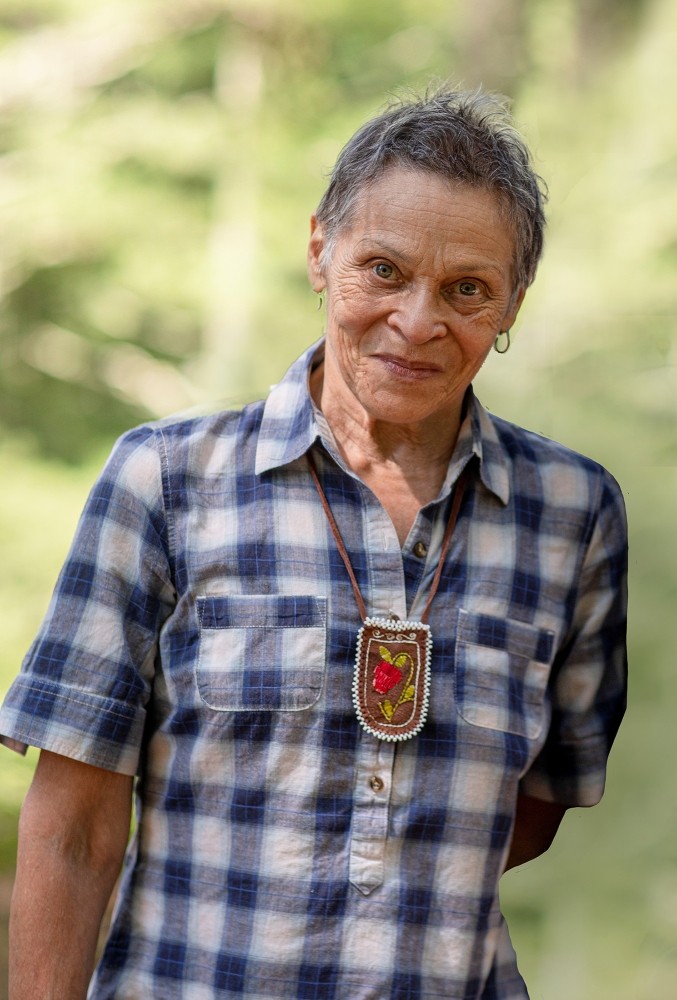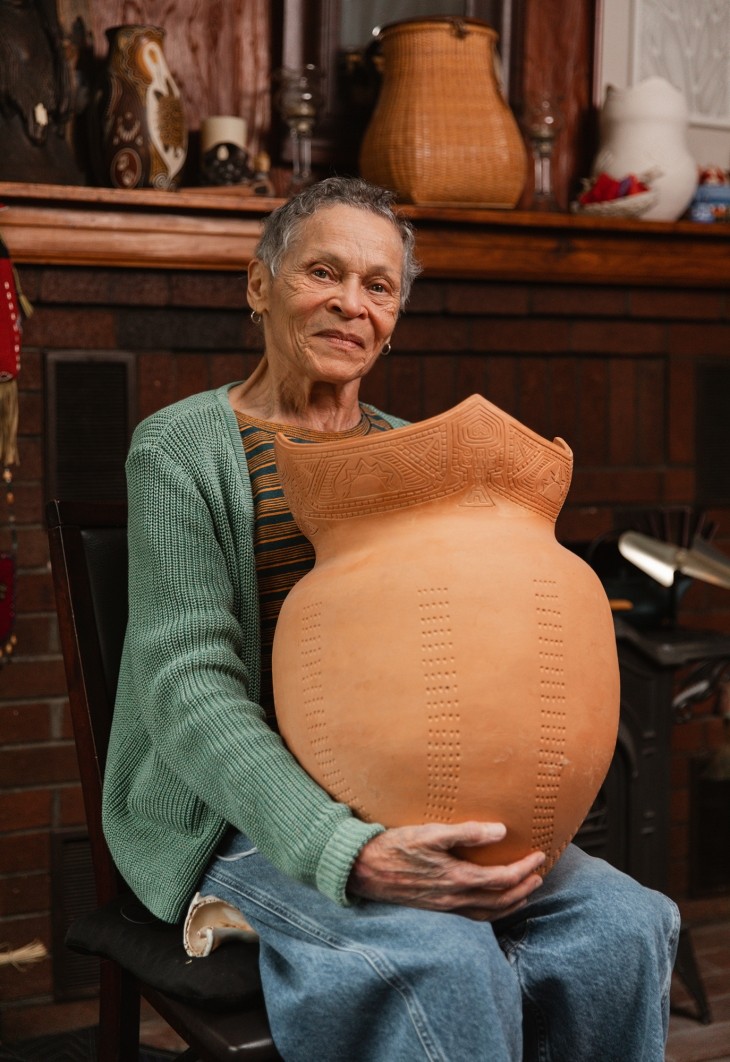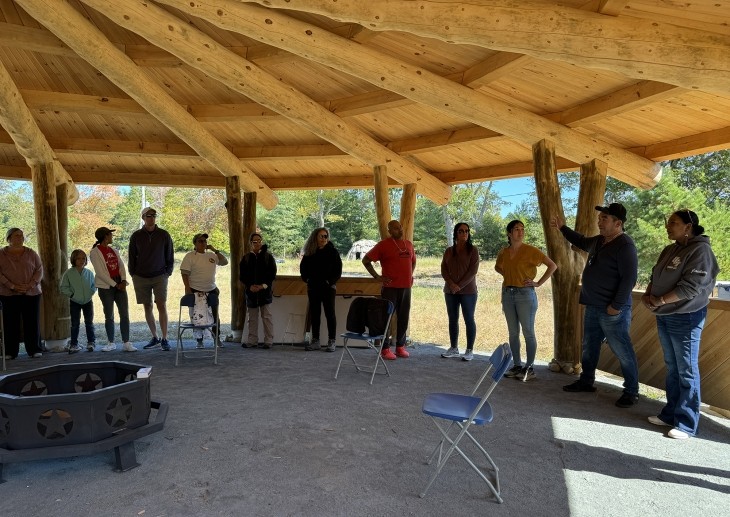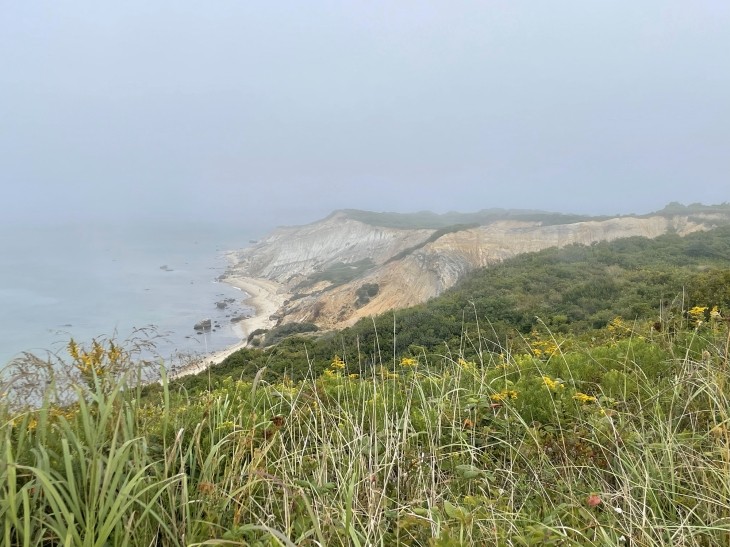
Ramona Peters is a member of the Mashpee Wampanoag Tribe, who have called the land that is now eastern Massachusetts and eastern Rhode Island home for more than 12,000 years. She is the founder and president of Native Land Conservancy. After decades of teaching and then working in tribal preservation and community development, she turned to conservation work. Ramona’s focus is on securing access to the land for Indigenous people, and she is guided by the Wampanoag practice of always living in a state of thanksgiving.
I grew up on our family homestead on the Mashpee River, which goes five miles out to the Atlantic. I have six siblings, and two of my brothers and I spent a lot of time running up and down the trails. The trails are Mashpee Wampanoag trails that are thousands of years old. We weren’t allowed to stay in the house much, so I spent a lot of time outdoors and by the river. In South Mashpee, there’s Monomoscoy Island, which is another place that’s precious to me. I lived there and spent time with my grandfather there and birthed my daughter there. It’s right next to another river, but it’s surrounded by salt water. I played and fished there as well. I feel at home on those rivers. I circled back home about 18 years ago, and I ended up back in this house on the homestead.
I went to Bacone Indian Junior College in Oklahoma, and then I got recruited down to the University of Arizona in Tucson to participate in a pilot all-Indian education program. I got my bachelor’s degree in elementary education before moving home. When I came back to Mashpee, I mostly taught Indian education for kindergarten through 12th grade students after school, which is a kind of cultural education. It covers a lot: history, government, songs, dance, arts, crafts. And we camped and traveled sometimes. I did that for about 15 years.
I also began working in pottery when I was 25 or 26. I had started making things that come from our cultural ancestry after college, which I loved to do and still do. I made a lot of things that museums asked me to do, mostly working with wood and copper, and did artifact restoration. I was asked to make a pottery piece: a 17th century-style Wampanoag cooking pot. One of my roommates in college was Tewa from San Ildefonso Pueblo, New Mexico, and her grandmother was a potter. I watched her and how she did it, and what kind of things she foraged for, so later when I got this request, I thought, “Okay, I can do this.”
Working with clay was transformative for me; it’s definitely something that I need in my life. Handling it and understanding that it is the earth – I was humbled by that. I could feel that it was alive. When I made that first coil, I could almost see the pot that it was going to become. As I went along, I felt very tuned to into it. At an early age, it is very normal in the Wampanoag tradition to tune into the earth, but going to school sort of made me forget. By doing pottery, I learned a lot and I still do. Clays are all different: some of them need a lot of attention and some of them are easy to mold and fire. I get clay here in Massachusetts. Sometimes someone from the tribe will travel and bring back clay from different parts of the world, and it’s interesting to work with those.
Wampanoag pottery is referred to as a “lost” art because our people stopped using and making clay pots after the early English came in with their metal cooking pots. There’s now a few hundred years where pots like that weren’t made or used, only shards were found, but I’ve started making them again, trying to revive the form. At first it was for museums then for galleries. I’ve done courses for all different ages now, and it’s really fun to teach local tribal people. I sometimes do commission pieces, but it was never my main work. I also liked to make hickory bows and canoe paddles, and dugout canoes. Our ancestors made bandoliers, which are linked copper pieces, made by hammering small flat pieces of copper rolled around a branch to get the shape. That’s time intensive, but I like working with copper too.

I went back to school in 2006 to get a master’s degree in human and community development, did some traveling, and then I worked as the Mashpee tribal historic preservation officer. That involves many things: consulting with federal agencies that intersect with the tribe, monitoring archeological sites, managing grants and fifteen staff members. I directed the museum and developed exhibits and designed the tribal archives. We have a meeting house that was built in 1684 and then renovated three times, and through the years it has also been a go-to place for tribal weddings, funerals, and other events, so I took care of the building as well.
The idea for the Native Land Conservancy grew out of listening to elders. In our community, your voice comes later – at first you learn just to be quiet and listen to those older than you. I heard a lot of people lamenting about the land being damaged, about losing different medicinal plants, natural foods, ceremonial grounds and losing access to burial sites. I grew up hearing that and knew I wanted to do something about it. I didn’t know what – I didn’t really know about conservation. In Indian country, it wasn’t something that was talked about in those words. Once I really learned about conservation, I was excited about it as a tool. The Native Land Conservancy has an all-Native led board from five different tribal groups. The idea is to help Native people regain access to land and water.
I was shocked initially to learn how much of conservation is really about real estate. The process is often complicated and can take years. The first donated parcel is one we call “Tall Pines.” It’s a small woodlot in Barnstable that was given to us by Norman Hayes. It was in his family for many generations. Mr. Hayes has a hobby of measuring tall pines all over Cape Cod. Since his donation he typically joins us at our annual meetings. He once gave me a little bird point, a projectile for hunting birds, that he found there. He said he always felt the presence of Native people there, and knowing of the history of the land, that’s what compelled him to give it to us. Although the process – even for a donation of land – can be expensive and takes time, the generosity of people has been enormous.
The Native Land Conservancy holds deeds to about 200 acres now, and we have conservation restrictions on 811 acres, plus cultural respect easements on 460 acres. We are mostly in the Northeast, especially in Massachusetts, though we have a few holdings and easements outside the Northeast. We protect white pine and oak forests, three small islands, wetlands and a bog. There’s great habitat for black bears, porcupines, otters, turkey, fox, deer, bats. Stewardship begins with allowing the earth’s intelligence to inform us – to help us consider all the other living things. We’re taught to make offerings and ask for permission and guidance from the land before doing anything. You wait for a response to guide you on what you can and cannot – or should not – do. The only thing left in many of these historic sites are shards of pottery and arrowheads. I think that’s a reminder; we’re taught to minimize how much we leave behind as humans in our habitats, to be modest in what we accumulate and think about the impact of it. Our executive director, Diana Ruiz, has a PhD in ecology and evolutionary biology, so we are always informing ourselves through that lens as well. We do environmental assessments and employ two people on our land management team who have a background in this work and are also Native people who have a relationship with this land. And we have knowledgeable people in the community: people to go to about fish, people to ask about birds, plant life – and so we go to these experts.
We began making use of cultural respect easements after learning about them from some California tribes about 10 years ago. There aren’t a lot of places in the Northeast that use them yet, but we help other tribal groups in the region understand them. They use that same legal language of other easements, but this kind outlines access for Indigenous people to forage for things that we need to sustain our culture as well as visit ceremonial and burial grounds. We need to have access to bulrush and cattail leaves for weaving and making mats, and access to hickory and apple wood to smoke fish, as well as other things. We have these easements now with landowners and some towns. It’s important to have that partnership drawn out. Not only does it help us develop protocols and policies to be more sustainable in harvesting, but it also gives us a way to ask for privacy during important ceremonies. And many of our people don’t feel safe in the woods now, because of harassment. These easements offer another layer of safety and protection while we commune with nature without needing a deed.
There’s a place in Middleborough called Nemasket River Village that we help protect. It’s the site of an ancient Wampanoag village that was used consecutively for over 8,000 years. We contributed a third of the purchase money and co-hold the restriction with The Archaeological Conservancy. We retain a cultural respect easement there that allows our people to stay overnight, and the land belongs to the Town of Middleborough now. There’s a Wampanoag canoe passage, about a 90-mile trip, that goes right along that parcel. It was about to be developed, but they found post molds that revealed 69 dwellings and thousands of artifacts and a burial site. It took over 12 years to raise the funds to protect that, but we got it done. That was very exciting.
The greatest joy for me is seeing people on the land, getting to do these things, and having access again. I appreciate all conservation, but I especially am dedicated to the tribal people, which is important because we haven’t had that space. It’s good to see people and see families out on the land, getting sustenance as well as spiritual benefits from the land we protect.





Discussion *